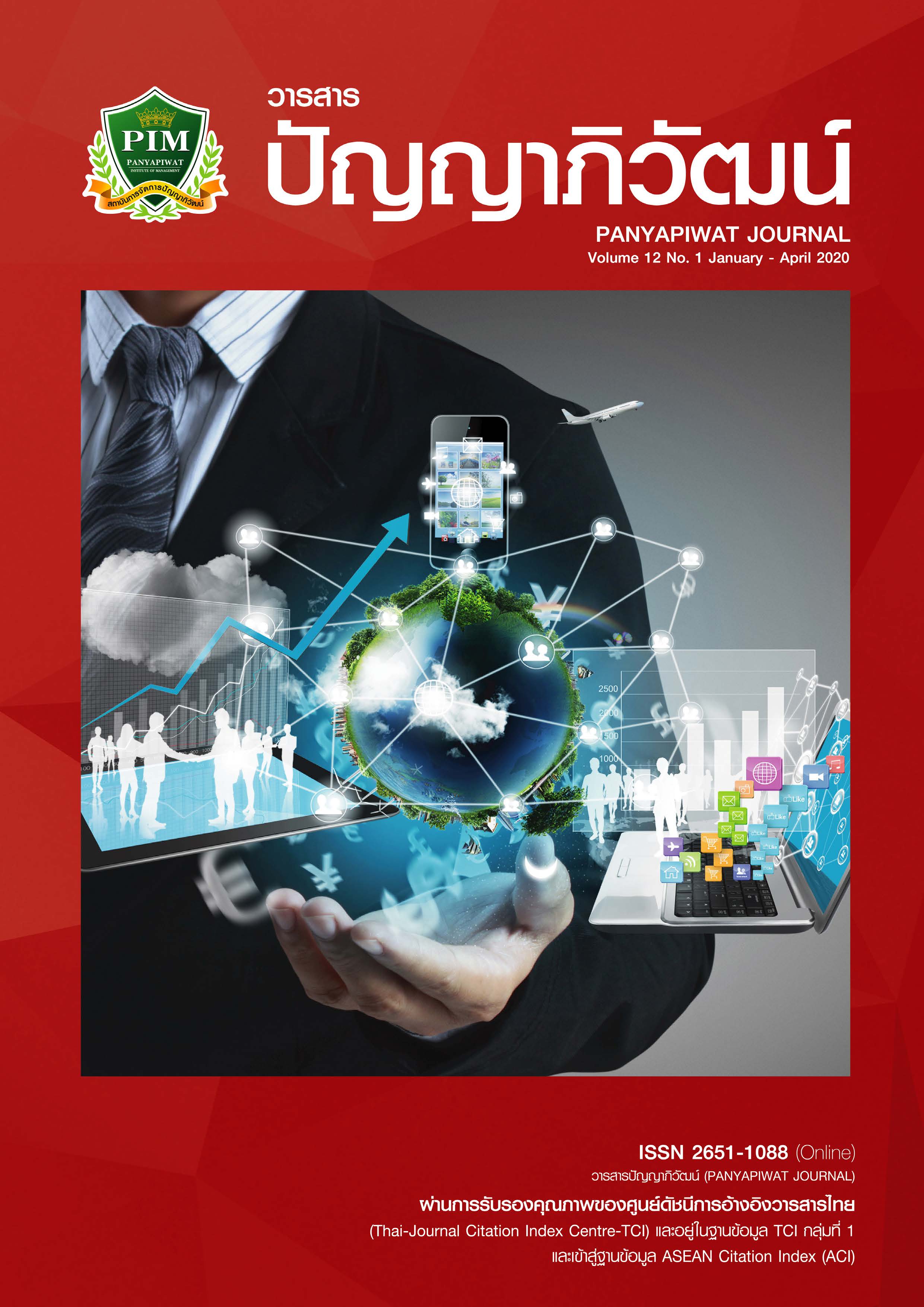การตอบสนองเชิงวัจนภาษาและอวัจนภาษาของผู้บริหารบริษัทต่อวิกฤต: กรณีศึกษาเปรียบเทียบระหว่างสายการบินมาเลเชีย MH370 กับสายการบินแอร์เอเชีย QZ8501
Main Article Content
บทคัดย่อ
วิกฤตถือเป็นสิ่งสำคัญที่ต้องทำการสื่อสารและจัดการ ผู้บริหารบริษัทถือเป็นบุคคลที่มีหน้าที่สำคัญในการจัดการวิกฤตที่เกิดขึ้น มิเช่นนั้นแล้วย่อมมีผลกระทบในเชิงลบต่อภาพลักษณ์และชื่อเสียงขององค์กร วัตถุประสงค์ของงานวิจัยนี้คือ เพื่อเปรียบเทียบการตอบสนองของผู้บริหารบริษัท โดยพิจารณาทั้งในเชิงวัจนภาษาและอวัจนภาษา โดยใช้กรณีศึกษาของสายการบินมาเลเชีย MH370 และสายการบินแอร์เอเชีย QZ8501 วัจภาษาและอวัจนภาษาที่ปรากฏในคลิปวิดีโอของงานแถลงข่าวภายหลังจากการสูญหายของสายการบิน MH370 และ QZ8501 ถูกนำมาถอดความและวิเคราะห์ ผลการวิจัยพบว่า วัจนภาษาที่ผู้บริหารสายการบินแอร์เอเชีย QZ8501 ไม่ว่าจะเป็นการนำเสนอเนื้อหาและศัพท์ต่างๆ ที่ใช้แสดงให้เห็นถึงอารมณ์ความรู้สึกของความห่วงใย ความสูญเสีย และความเจ็บปวดอย่างที่สุด ซึ่งแสดงออกอย่างจริงใจมากกว่าวัจนภาษาที่นำเสนอโดยผู้บริหาร สายการบินมาเลเซีย MH370 นอกจากนี้อวัจนภาษายังยืนยันวัจนภาษาที่เกิดขึ้นนี้ด้วย งานวิจัยนี้ยังประโยชน์ ให้เกิดขึ้นกับทั้งผู้บริหารบริษัท และนักประชาสัมพันธ์สำหรับการสร้างแบรนด์ให้เกิดขึ้นทั้งในเชิงของผู้จ้างงาน และพนักงาน เพื่อป้องกันภาพลักษณ์และชื่อเสียงที่ไม่ดีซึ่งสามารถเกิดขึ้นกับองค์กรได้
Article Details
“ข้าพเจ้าและผู้เขียนร่วม (ถ้ามี) ขอรับรองว่า บทความที่เสนอมานี้ยังไม่เคยได้รับการตีพิมพ์และไม่ได้อยู่ระหว่างกระบวนการพิจารณาลงตีพิมพ์ในวารสารหรือแหล่งเผยแพร่อื่นใด ข้าพเจ้าและผู้เขียนร่วมยอมรับหลักเกณฑ์การพิจารณาต้นฉบับ ทั้งยินยอมให้กองบรรณาธิการมีสิทธิ์พิจารณาและตรวจแก้ต้นฉบับได้ตามที่เห็นสมควร พร้อมนี้ขอมอบลิขสิทธิ์บทความที่ได้รับการตีพิมพ์ให้แก่สถาบันการจัดการปัญญาภิวัฒน์หากมีการฟ้องร้องเรื่องการละเมิดลิขสิทธิ์เกี่ยวกับภาพ กราฟ ข้อความส่วนใดส่วนหนึ่งและ/หรือข้อคิดเห็นที่ปรากฏในบทความข้าพเจ้าและผู้เขียนร่วมยินยอมรับผิดชอบแต่เพียงฝ่ายเดียว”
เอกสารอ้างอิง
Adi, F. & Kartikawangi, D. (2016). The airline crisis communication: A text analysis of AirAsia’s press release related to the plane crash from December 28, 2014–March 4, 2015. The 3rd International Conference on Corporate and Marketing Communication. Jakarta, Indonesia: Atma Jaya Catholic University of Indonesia.
Ahmad, D. A. M. A., Ashari, N. M. & Samani, M. C. (2017). Effects of rational and emotional framing on highly involved audience in severe crisis situation: An experimental study on MH370. Malaysian Journal of Communication, 33(2), 89-104.
Aircraft investigation. (2014). AirAsia QZ8501 investigation, timeline, updates. Retrieved November 22, 2018, from https://www.mh370investigation.com/p/blog-page.html
Awani, A. (2014). MAS press conference on the missing MH370 KL-Being Flight. Retrieved May 1, 2018, from https://www.youtube.com/watch?v=kSfPDEZbPSo
Azam, M. (2015). Conversation analysis. Retrieved November 22, 2018, from https://www. slideshare.net/almubbarki/conversation-analysis-50119653
Chung, S. & Lee, S. (2016). Crisis communication strategy on social media and the public’s cognitive and affective responses: A case of Foster Farms Salmonella outbreak. Communication Research Reports, 33(4), 341-348.
Claeys, A. & Cauberghe, V. (2014). Keeping control: The importance of nonverbal expressions of power by organizational spokespersons in times of crisis. Journal of Communication, 64(6), 1160-1180.
CNN staff. (2017). Timeline of MH370 disappearance. Retrieved November 22, 2018, from https://edition.cnn.com/2017/01/17/world/asia/malaysia-airlines-flight-370-timeline/index.html
Coombs, W. T. (2007). Crisis management and communications. Retrieved August 30, 2017, from https://www.facoltaspes.unimi.it/files/_ITA_/COM/Comunicazione_di_Impresa_-_Crisis_ Management_and_Communications.pdf
Crijns, H., Claeys, A. Cauberghe, V. & Hudders, L. (2017). Who says what during crises? A study about the interplay between gender similarity with the spokesperson and crisis response strategy. Journal of Business Research, 79, 143-151.
De Waele, A. & Claeys, A. (2016). Nonverbal cues of deception in audiovisual crisis communication. Public Relations Review, 43(4), 680-689.
Eunson, B. I. (2012). Non-verbal communication. Retrieved May 1, 2018, from https:// www.researchgate.net/profile/Baden_Eunson2/publication/275965639_Non-Verbal_Communication %20/links/554c61530cf29752ee7edf31/%20Non-Verbal%20Communication.pdf?origin= publication_detail
Huang, Y. C., Wu, F. & Cheng, Y. (2016). Crisis communication in context: Cultural and political influences underpinning Chinese public relations practice. Public Relations Review, 42(1), 201-203.
Isyar, O. G. (2008). Definition and management of international crises. Retrieved April 7, 2019, from https://sam.gov.tr/wp-content/uploads/2012/02/OmerIsyar.pdf
Lee, S. & Chung, S. (2012). Corporate apology and crisis communication: The effect of responsibility admittance and sympathetic expression on public’s anger relief. Public Relations Review, 38(5), 932-934.
Lin, X., Spence, P. R., Sellnow, T. L. & Lachlan, K. A. (2016). Crisis communication, learning and responding: Best practices in social media. Computers in Human Behavior, 65, 601-605.
Lucas, A. (2018). The importance of verbal & non-verbal communication. Retrieved June 3, 2019, from https://www.livestrong.com/article/156961-the-importance-of-verbal-non-verbal-communication/
Maiorescu, R. D. (2016). Crisis management at General Motors and Toyota: An analysis of gender-specific communication and media coverage. Public Relations Review, 42(4), 556-563.
Patelli, L. & Pedrini, M. (2014). Is the optimism in CEO’s letters to shareholders sincere? Impression management versus communicative action during the economic crisis. Journal of Business Ethics, 124(1), 19-34.
Paz-Soldan, M. (2018). Getting emotional: Emotions’ role in crisis communication. Retrieved December 31, 2018, from https://instituteforpr.org/getting-emotional-emotions-role-in-crisis-communication/
Pere, A. (2015). MH370 and from the LIVE Konferensi Pers Official dari CEO Air Asia Tony Fernandez [FULL 28 December 2014. Retrieved November 25, 2018, from https://www. youtube.com/watch?v=YkD7eMaddGU
Rahmatainment. (2014). Airasia CEO Tony Fernandez, give a press statement on the loss plane Airasia. Retrieved May 1, 2018, from https://www.youtube.com/watch?v =sjKbeM3Ura8
Sohn, Y. J. & Lariscy, R. (2012). Resource-based crisis management: The important role of the CEO’s reputation. Journal of Public Relations Research, 24(4), 318-337.
Strandberg, J. M. & Vigso, O. (2016). Internal crisis communication: An employee perspective on narrative, culture, and sensemaking. Corporate Communications: An International Journal, 21(1), 89-102.
Terinte, P. (2016). Content analysisi of CEO statement and auditor’s recommendation: A case study of Banca Transilvania. Journal of Public Administration, Finance & Law, 9, 93-107.
Tilley, J. (2014). Analysis: Malaysia Airlines’ mishandled response to the MH370 crisis. Retrieved January 25, 2019, from https://www.prweek.com/article/1286333/analysis-malaysia-airlines-mishandled-response-mh370-crisis
Ugoalah, C. (2015). Quality visibility in CEO response: Connecting to authenticity following a crisis. 4th International Conference on Crisis Communication in the 21st Century, 7-10 October 2015 in Helsingborg, Sweden. Retrieved May 1, 2018, from https://www.isk.lu.se/sites/isk. prodwebb.lu.se/files/chigo_ugoalah.pdf
Westphal, J. D., Park, S. H., McDonald, M. L. & Hayward, M. L. A. (2012). Helping other CEOs avoid bad press: Social exchange and impression management support among CEOs in communications with journalists. Administrative Science Quarterly, 57(2), 217-268.
Wonink, V. E. (2017). Does it matter how close you are: A scenario-based experimental study about the effects of crisis proximity, crisis source and crisis framing on purchase intention, the willingness to forgive, trust and emotion. Master thesis: University of Twente. Retrieved December 31, 2018, from https://essay.utwente.nl/73191/1/ Wonink_MA_BMS.pdf
Yao, H. & Lai, Y. (2018). Facial expressions and verbal response strategies in postcrisis communication. Journal of Business and Technical Communication, 33(1), 91-111.
Zafra, N. & Maydell, E. (2018). Facing the information void: A case study of Malaysia Airlines’ media relations and crisis communication during the MH370 disaster. Asia Pacific Public Relations Journal, 19, 41-65.


